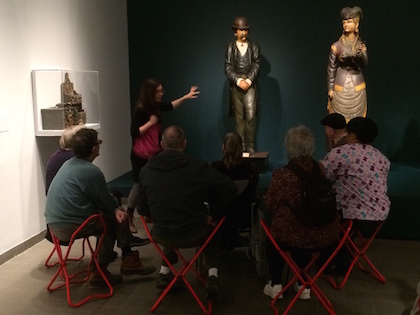
BY JACKSON CHEN | It was half past two on the first Thursday afternoon of the month at the American Folk Art Museum in Lincoln Square. A museum educator introduced the afternoon’s theme to attendees of an hour-long interactive discussion program.
For the 15 participants, the gathering is a monthly ritual they attend with their family members or care partners to help them put aside for a time their battle with Alzheimer’s, dementia, or memory loss.
Alzheimer’s is a progressive brain disease that destroys memory and other important mental functions through atrophy of brain cells. It is the leading cause of dementia, accounting for between 60 and 80 percent of all cases, according to the Alzheimer’s Association, a nonprofit health organization active in all aspects related to the disease.
With help from the Association’s New York chapter, the Folk Art Reflections program was created in early 2009 and has become the museum’s signature interactive program.
The museum’s once-a-month program lasts from 2:30 to 3:30 p.m. and is limited to 15 participants, plus the loved ones and caregivers they bring along. The program’s topic is based on a set theme established by the museum, which changes three times a year.
According to the museum’s diretor of education, Rachel Rosen, discussion themes have ranged from broad topics like visual patterns or sculptures to narrower subjects like gender expression in the 19th century.
“Our collection is so diverse… and unique to being able to inspire connections for people living with memory loss,” Rosen said of the museum’s works.
She added that many of the art objects have narrative qualities that provide a strong basis for discussion.
In addition to traditional paintings, the Folk Art Reflections program sometimes adds a tactile component — like quilt or rug artworks — to allow participants another dimension to connect to.
“What’s very important to families is maintaining a high quality of life and making sure there’s beauty remaining in their lives,” Rosen explained. “This program is designed to hopefully, and in a very thoughtful way, meet some of those needs.”
She said that formal evaluations of the program plus a steady amount of loyal regulars and the support from their family members convinced her that it is successful in taking participants’ minds off the limitations they experience due to Alzheimer’s disease.
“I’ve had one-on-one discussions with family members and care partners,” Rosen said. “They’re always talking about back at home, or later that day, or the next day, they will hear from the patient about a recollection about an artwork or a moment in the museum.”
Rosen said the program is careful to cater to the crowd by moving the discussion at participants’ pace. If there’s a work of art that the group is collectively interested in, she said, the afternoon session is adjusted accordingly by spending a little more time on what they connect to.

“We’ve had participants who are not very verbal for months and months,” Rosen said. “Suddenly, they’ll be looking at a work of art and they’ll share something from their childhood, something that stands out from their own lived experience that they see in the artwork.”
Half a dozen years into the museum’s efforts, Rosen said there are now more programs using art as a way to deal with Alzheimer’s and its prevalence in the senior community.
Despite having such a high occurrence — 2015 studies show 5.3 million Americans with Alzheimer’s — little is known about the mentally destructive disease. Ninety percent of what is known about Alzheimer’s was discovered in the last 15 years, according to the Association. Still, there is not yet a solid explanation for the causes of the disease and no direct cure.
However, it was emerging research being done at the time with art and Alzheimer’s that inspired the museum to launch the program back in 2009.
“At that point, there was more and more scholarship and research coming out about art’s tie, positive influence, and what effect that could have on memory loss, Alzheimer’s, and dementia,” Rosen said.
She explained that the museum worked intensively with the Alzheimer’s Association, which knew more about the research into art and its effect on the disease. At the time, there weren’t many programs like what the American Folk Art Museum was designing, Rosen said, with only the Museum of Modern Art’s Alzheimer’s Project already in the field.
“There is undeniably a growing need for there to be quality resources that address this part of the senior population,” Rosen said of art and Alzheimer’s programs. “This is only going to become more and more true.”
Similar to how her museum observed the existing MoMA Alzheimer’s program in developing its own, Rosen said that the Rubin Museum of Art has followed the same example by sitting in on the Folk Art Reflections program in developing a free tour program for its visitors with Alzheimer’s or dementia.
“For Folk Art Reflections and programs similar to ours,” Rosen said, “our goal is really to make a small part of everyone’s day not the focus of an individual being defined by their disease.”






































